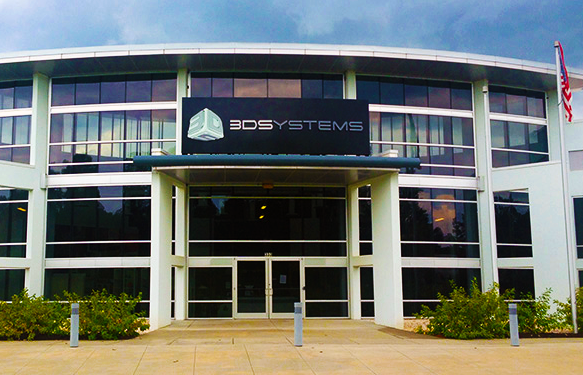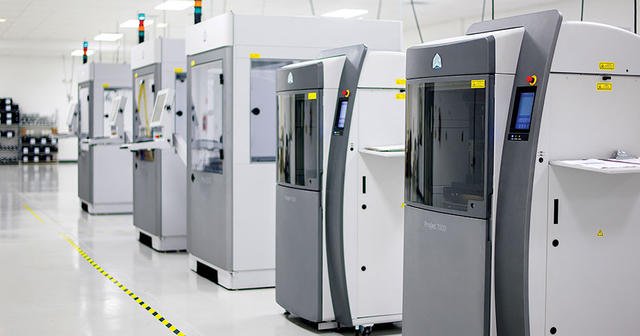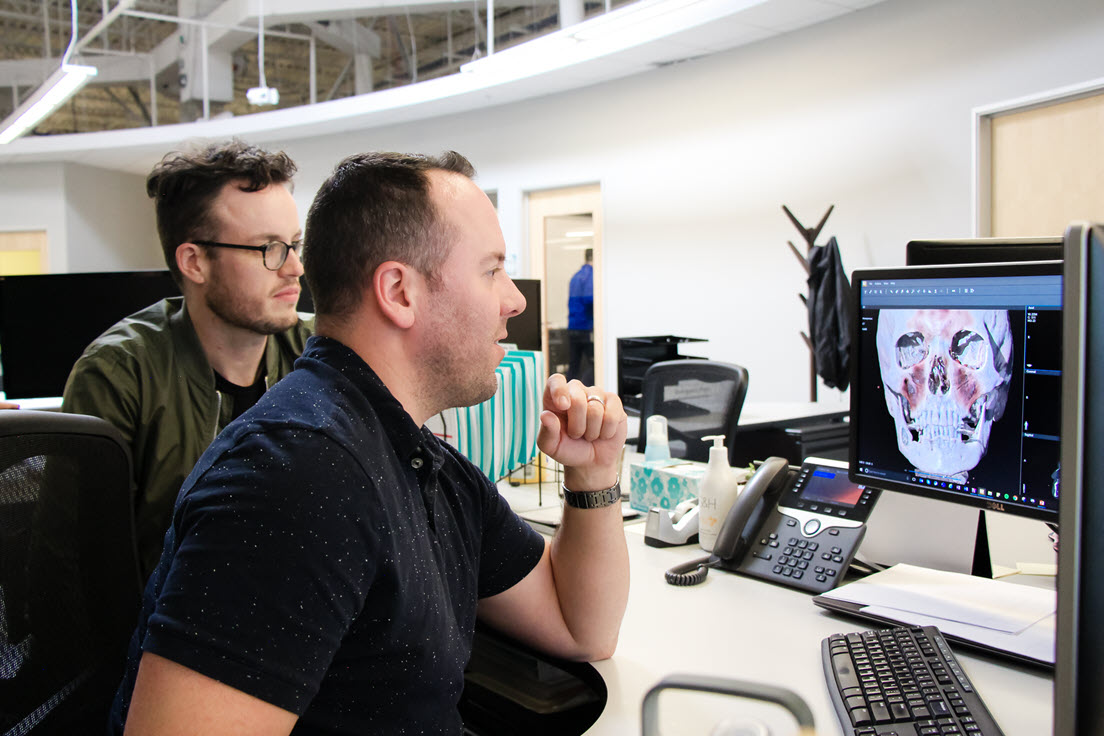Jeffrey Graves, the new CEO of 3D printer manufacturer 3D Systems, outlined his strategic vision during this week’s announcement of financial results.
In his first public outing as the firm’s CEO, Graves announced that the 3D Systems would be imminently restructured to focus on its healthcare and industrial verticals. Segments of the company’s business that don’t align with its new strategy could be divested, as the firm seeks to reduce its operating costs by $100 million. Part of this restructuring will see the workforce cut by 20 percent as part of the plan to make it profitable by next year.
Following the release of its quarterly figures, 3D Systems’ shares slumped by 11 percent, falling from $7.06 to a low of $6.12. The company summarily announced an equity offering program, making $150 million worth of shares available for purchase. 3D Systems intends to use any proceeds from the sales to repay its outstanding long-term debt.
During an earnings call with investors and analysts, Graves explained why the restructuring plan is necessary for the future of the firm. “In this organizational realignment, we have an opportunity to maximize efficiencies with a need to align our operating costs with current revenue levels,” said Graves. “This reduction in force is a difficult but essential step in our ongoing strategic process, designed to better position the company for sustainable and profitable growth.
“I would like to express my appreciation to each of the employees impacted by this decision for their dedicated service,” added Graves.

3D Systems’ revenue for Q2 2020
For the three months ending June 30, 2020, 3D Systems generated net revenue of $112.1 million, a reduction of 28 percent on the $157.3 million reported in Q2 2019. Over the first half of 2020, the company earned a combined revenue of $246.8 million, a decline of 20 percent on the $309.3 million reported in H1 2019.
3D Systems’ reports revenue across two divisions: Products and Services. The former accounts for the company’s revenue generated by 3D printers, software, and materials. Services include the revenue earned from the company’s healthcare solutions and its general on-demand manufacturing capabilities.
| Revenues ($) | Q1 2020 | Q1 2019 | Variance (%) | H1 2020 | H1 2019 | Variance (%) |
| Products | 61.4m | 93.7m | -34 | 140.3m | 186.1m | -24 |
| Services | 50.5m | 63.5m | -20 | 106.4m | 123.1m | -13 |
| Total Revenues | 112m | 157.2m | -28 | 246.7m | 309.2m | -20 |
In the most recent financials, the firm’s Products generated $61.4 million in revenue, a 34 percent reduction compared to the $93.7 million reported in Q2 2019. For the first half of 2020, the 3D Systems’ Products segment generated $140.3 million, a 24 percent decrease on the $186.1 million reported in H1 2019.
Products from 3D Systems’ two main target verticals, saw their revenue decrease. The company’s healthcare products generated $50 million in Q2 2020, an 11 percent decline on Q2 2019. Revenue from 3D Systems’ industrial business dropped as well, falling by 37 percent to $62.1 million between Q2 2020 and Q2 2019.
The company’s Services division reported revenue of $50.5 million, a 20 percent reduction compared to the $63.5 million earned in the same period last year. In H1 2020, Services declined by 13.5 percent, with revenue reduced to $106.4 million from $123.1 million in H1 2019.
| Operating expenses ($) | Q1 2020 | Q1 2019 | Variance (%) | H1 2020 | H1 2019 | Variance (%) |
| Selling, general and admin | 52m | 71m | -27 | 108.1m | 136.7m | -21 |
| Research and development | 16.9m | 20.8m | -19 | 36.2m | 42.7m | -14 |
| Total operating expenses | 69m | 92.4m | -25 | 144.3m | 179.4m | -20 |
3D Systems has already started to reduce its operating expenses in order to account for the drop in demand caused by the ongoing pandemic. The company’s total operational costs decreased from $92.4 million in Q2 2019 to $69 million in Q2 2020. Overall, for the first half of 2020, the company spent $144.3 million on operational expenses, compared to $179.4 million in H1 2019.
Other 3D printing firms have also reduced their expenditure due to the collapse in customer demand caused by the COVID-19 pandemic. Stratasys has cut its workforce by 10 percent to make it’s business “leaner” and Groupe Gorgé is reducing its output to mitigate its losses from declining revenue.
3D Systems held $125 million worth of inventory on June 30th, 2020, an 11 percent increase on the $111.1 million it had at the end of the last financial year. Additionally, the firm’s assets fell from $133.6 million at the start of Q1 to $63.9 million by the end of Q2. While 3D Systems did put $20 million towards paying off outstanding debts, its depleted cash reserves further indicate the impact of the company’s fall in revenue.

3D Systems’ efficiency savings plan
Discussing the company’s decline in revenue during the earnings call, Graves outlined the company’s restructuring plan in greater detail. “We’re simplifying and focusing our organization by realigning the company to serve applications in two key market verticals, healthcare and industrial,” said Graves. “Moving forward, we will no longer emphasize the individual software, hardware, and materials elements of additive manufacturing separately, rather than the combination of these elements into specific application solutions within our targeted markets.”
3D Systems released new 3D printing materials and software over the second quarter, and these will now be part of the company’s more focused offering. The firm announced two new versions of its Geomagic Design X and Geomagic Wrap 3D software packages, designed to streamline scan workflows. 3D Systems also expanded its portfolio of materials, introducing new polymers for its Figure 4 platform.
Within the healthcare sector, the company will now focus on dental, medical devices, surgical planning, and simulation. 3D Systems’ industrial business will encompass aerospace, defense, automotive, and durable goods. By targeting a smaller number of markets, the firm is aiming to build success through developing niche products with specific applications.

Graves clarified why 3D Systems was changing its approach and emphasized the importance of combining the firm’s 3D printing services. “When Chuck Hull founded our company based on his invention of 3D printing, he brought together for the first time hardware, software, and material science in a unique way, “ said Graves. “Since that time, we’ve taken delight, often to the point of distraction in advancing the individual elements of the process, and forgotten that the true value is in their unique combination.”
Moving into the third quarter, 3D Systems is planning to make cuts to its site costs, to reduce its operating expenses. COVID-19 has accelerated the company’s plans to work remotely, and it’s now considering factory and office closures shortly. 3D Systems has said it’s ready to incur charges of $25-30 million for closing the facilities, to make long-term savings for the future.
Concluding the earnings call, Graves summarized that although the company was having to make tough choices, it still had a strong role to play in the 3D printing industry. “This restructuring involves eliminating $100 million of cost over the next 18 months while investing for growth in key application areas,” said Graves. “With a clear statement of purpose and a return to the ideals we were founded on, I believe 3D systems will be a leader in additive manufacturing and will be central to the value creation that it will enable.”
You can now nominate for the 2020 3D Printing Industry Awards. Cast your vote to help decide this year’s winners.
To stay up to date with the latest 3D printing news, don’t forget to subscribe to the 3D Printing Industry newsletter or follow us on Twitter or liking our page on Facebook.
Looking for a job in the additive manufacturing industry? Visit 3D Printing Jobs for a selection of roles in the industry.
Featured image shows 3D Systems’ headquarters in Rock Hill, South Carolina. Photo via 3D Systems.



